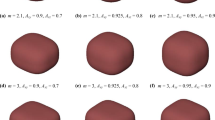Abstract
A Discrete Elements Method (DEM) study of load movement within a SAG mill 12,192 × 7620 (40′ × 25′) in normal operating conditions is performed. The purpose is to determine how the geometry of the lifters affects the kinetics of the load inside the mill. Specifically, the changes produced by the incorporation of inclined lifters and spiral or helicoidal pulp lifters to the kinetics are evaluated. Four study cases are identified: first, the base case corresponds to a conventional geometry; the second case corresponds to inclined lifters incorporation; third case corresponds to a mill with helicoidal discharge; and the fourth case corresponds to a mill with inclined lifters and helicoidal pulp lifters. To save computational resources, the water that enters the mill has been modeled by varying the coefficient of restitution. The results of a series of experiments are presented to determine how this coefficient varies when having impacts on surfaces with different liquid levels. A comparative analysis is made of the following variables: mean transport speed and material flow, for normal operating conditions. Taking as reference the mill with straight lifters and radial pulp lifters (case 1), the case with the inclined lifters and radial pulp lifters increases the material discharge flow less to 76 mm of size by 5.1%, and this value increases even more when the helicoidal pulp lifters are incorporated reaching a 58.6%. The most significant change is seen in the flow through the grates and the pulp lifters discharge, which can increase substantially improving the operation.












Similar content being viewed by others
References
Aguilar-Corona A, Zenit R, Masbernat O (2011) Collision in a liquid fluidized bed. Int J Multiphase Flow 37:695–705
Cleary PW, Sinnot MD, Morrison R, Delaney GW (2017) Analysis of cone crusher performance with changes in material properties and operating conditions using DEM. Miner Eng 6:49–70
Cleary P.W., Morrison R.D., 2017, Comminution mechanisms, particle shape evolution and collision energy partitioning in tumbling mills, Miner Eng,86, February, Pages 75–95
Cruguer B, Salikov V, Heinrich S, Antonyuk S, Sutkar VS, Deen NG, Kuipers JAM (2016) Coefficient of restitution for particles impacting on wet surfaces: an improved experimental approach. Particuology 25:1–9
Cundall PA, Strack ODL (1979) A discrete numerical model for granular assemblies. Géotechnique 29(1):47–65
Delaney GW, Cleary PW, Morrison RD, Cummins S, Loveday B (2013) Predicting breakage and the evolution of rock size and shape distributions in Ag and SAG mills using DEM. Miner Eng 50–51:132–139
Djordjevic N, Shi FN, Morrison R (2004) Determination of lifter design, speed and filling effects in AG mills by 3D DEM. Miner Eng 17:1135–1142
Govender I, Cleary PW, Mainza AN (2013) Comparisons of PEPT derived charge features in wet milling environments with a friction adjusted DEM model. Chem Eng Sci 97:162–175
Gutierrez A, Guichou J (2014) Computational simulation of fracture of materials in comminution devices. Miner Eng 61:73–81
Jayasundara CT, Yang RY, Yu AB (2011) Discrete particle simulation of particle flow in a stirred mill effect of mill properties and geometry. University of New South Wales, Sydney, Australia
Kiangi K, Moys MH (2008) Particle filling and size effects on the ball load behavior and power in a dry pilot mill: experimental study. Powder Technol 187(1):79–87
Larsson IAS, Marjavaara BD, Lundstrom TS (2016) Simulation of the flow field in an iron ore pelletizing kiln. Miner Metall Process 33:144–148
Latchireddi S, Morrell S (2003) Slurry flow in mills: grate-only discharge mechanism (Part-1). Miner Eng 16(7):625–633
Legendre D, Daniel C, Guiraud P (2006) A note on modeling of the bouncing of spherical drops or solid spheres on a wall in viscous fluid. Chem Eng Sci 61:3543–3549
Marinack Jr M.C., Venkata, Jasti K., Young Eun Choi, C. Fred Higgs III, 2011,Couette grain flow experiments: the effects of coefficient of restitution, global solid fraction, and materials. Powder Technol, Volume 211, Pages 144–155
Mishra BK, Rajamani RK (1992) The discrete element method for the simulation of ball mills. Appl Math Model 16:598–604
Morrison R.D., Cleary P.W., 2004, Using DEM to model ore breakage within a pilot scale SAG mill, Minerals Engineering, Volume 17, Issues 11–12, Pages 1117–1124
Muller P, Bottcher R, Russell A, True M, Aman S, Tomas J (2016) Contact time at impact of spheres on large thin plates. Adv Powder Technol 27:1233–1243
Perez-Alonso CA, Delgadillo JA (2013) DEM--BM approach to predecting particle size distribution in tumbling mills. Miner Metall Process 30:145–150
Powell MS, McBride AT (2006) What is required from DEM simulations to model breakage in mills? Miner Eng 19(10):1013–1021
Powell MS, McBride AT (2004) A three-dimensional analysis of media motion and grinding regions in mills. Miner Eng 17:1099–1109
Rezaeizadeh M, Fooladi M, Powell MS, Mansouri SH (2010) Experimental observations of lifter parameters and mill operation on power draw and liner impact loading. Miner Eng 23(15):1182–1191
Sinnot MD, Cleary PW, Morrison RD (2017) Combined DEM and SPH simulation of overflow ball mill discharge and trammel flow. Miner Eng 108(2017):93–108
Weerasekara NS, Powell MS, Cleary PW, Tavares LM, Evertsson M, Morrison RD, Quist J, Carvalho RM (2013) The contribution of DEM to the science of comminution. Powder Technol 248:3–24
Xialei B, Wang G, Wang H, Wang S, Lv W (2017) Effect of lifter and mill speed on particle behavior, torque, and power consumption of a tumbling ball mill: experimental study and DEM simulation. Miner Eng 105:22–35
Yahyaei M, Banisi S (2010) Spreadsheet-based modeling of liner wear impact on charge motion in tumbling mills. Miner Eng 23:1213–1219
Funding
Financial support was provided by the DICYT Project 051516GS Universidad de Santiago de Chile USACH.
Author information
Authors and Affiliations
Corresponding author
Ethics declarations
Conflict of Interest
The authors declare that there is no conflict of interest.
Rights and permissions
About this article
Cite this article
Gutiérrez, A., Ahues, D., González, F. et al. Simulation of Material Transport in a SAG Mill with Different Geometric Lifter and Pulp Lifter Attributes Using DEM. Mining, Metallurgy & Exploration 36, 431–440 (2019). https://doi.org/10.1007/s42461-018-0007-9
Received:
Accepted:
Published:
Issue Date:
DOI: https://doi.org/10.1007/s42461-018-0007-9




